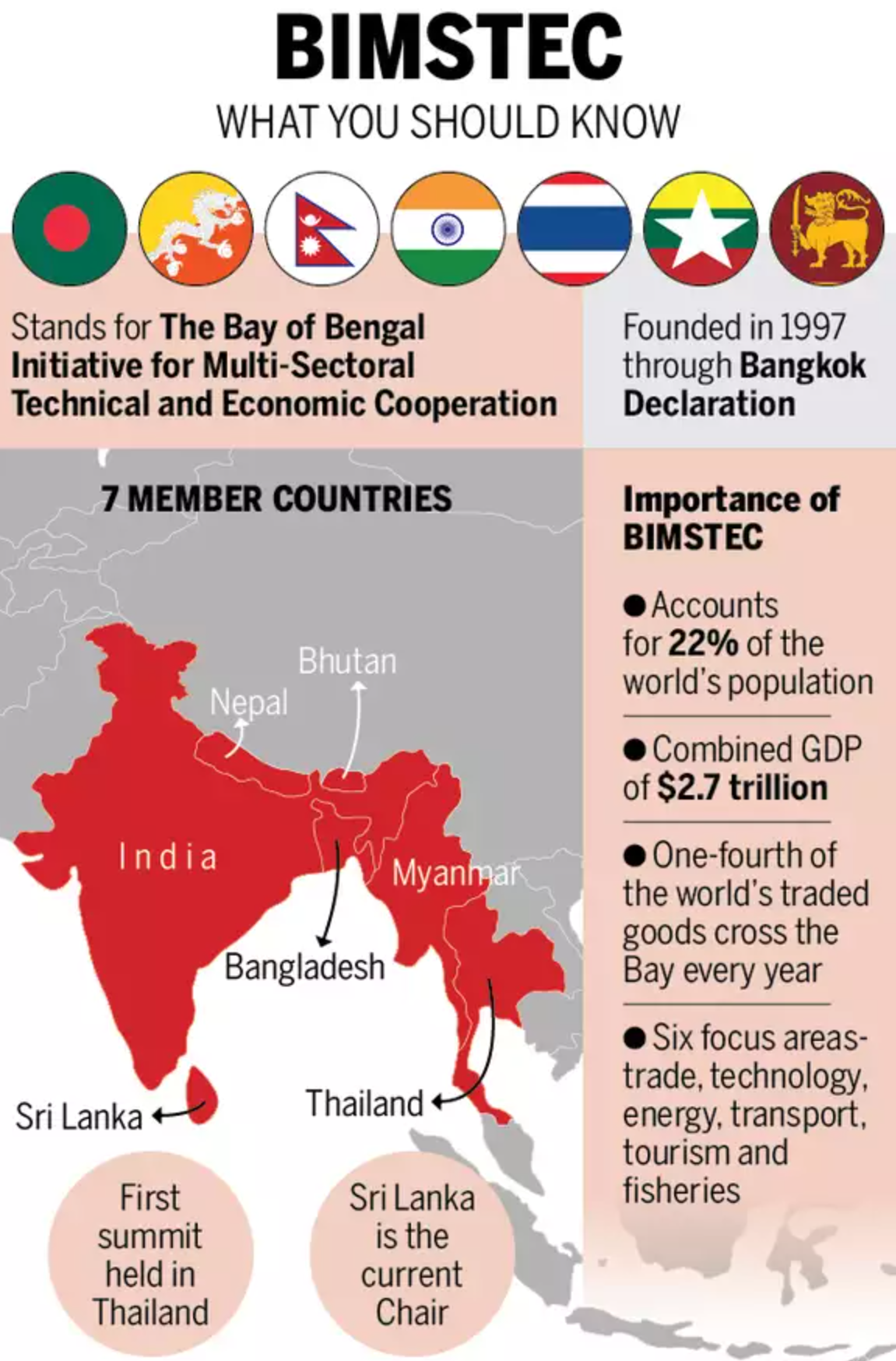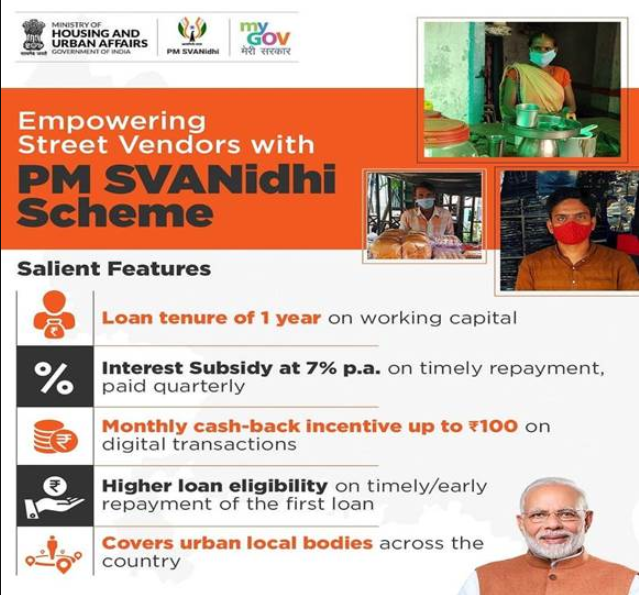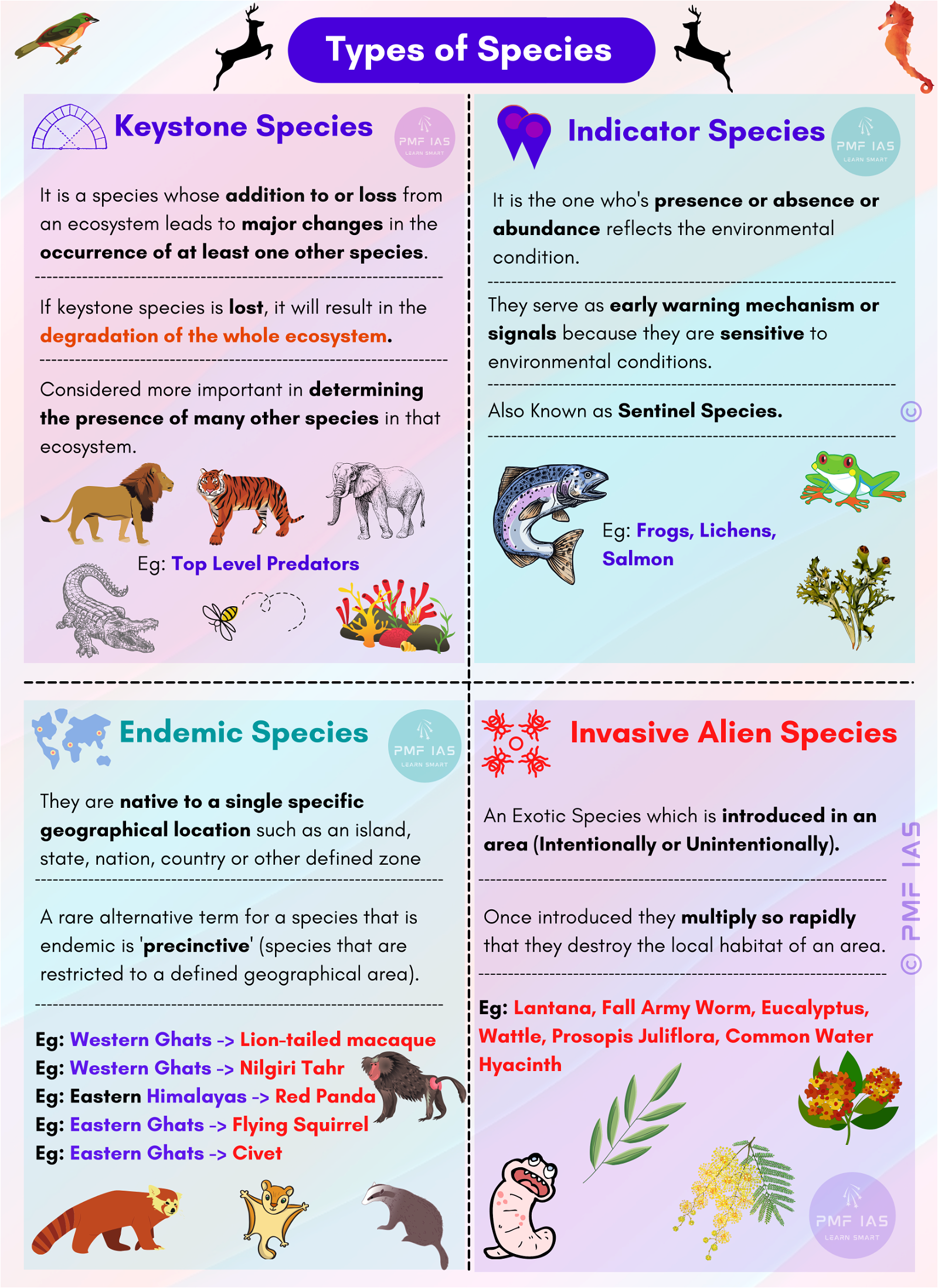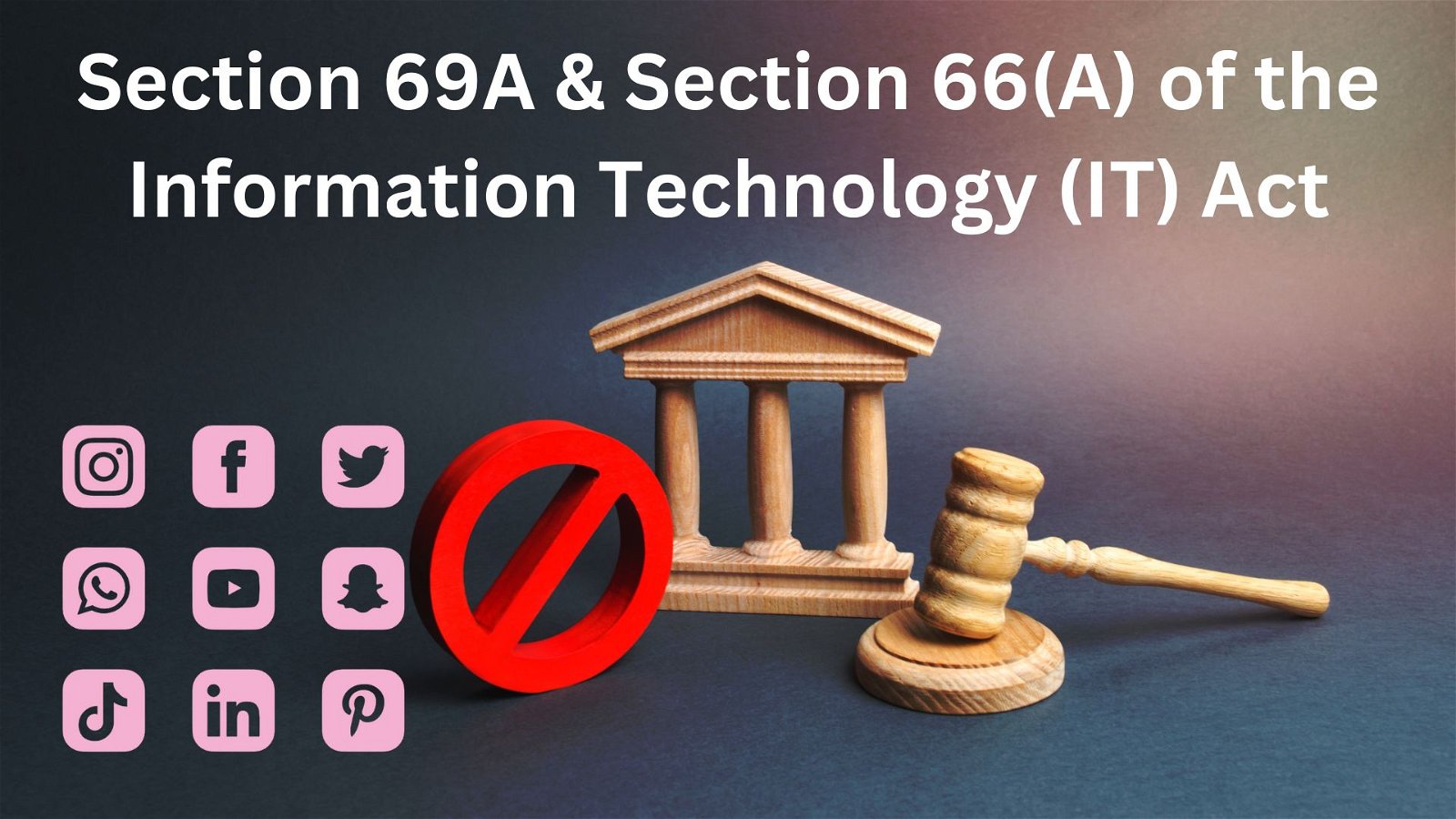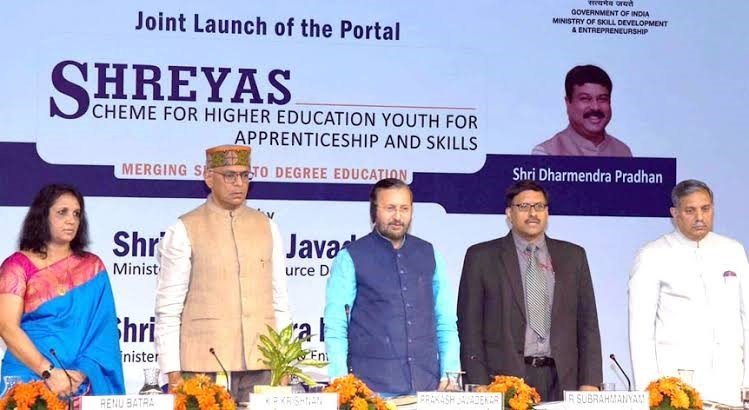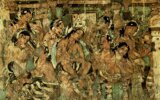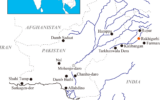{GS1 – Geo – PG – Climatology} Impact of Tonga Volcano’s Eruption on Weather
- Context (TH): The Hunga Tonga-Hunga Ha’apai (Hunga Tonga for short) eruption in 2022 in the Pacific Kingdom of Tonga could cause unusual weather for the rest of the decade.

Cooling Effect by Volcanic Smoke
- Volcanic smoke, particularly its sulfur dioxide, usually causes short-term cooling of the Earth’s surface.
- Sulfur dioxide forms sulfate aerosols that reflect sunlight back into space before it reaches the surface. This shading effect cools the surface until the sulfate settles or is washed away by rain.
Why Hunga Tonga’s Eruption in an Outlier?
- The Hunga Tonga’s eruption will not cause a cooling effect on the Earth’s surface. This is because it was an underwater volcano, so it produced little smoke but a lot of water vapour.
- The eruption’s immense heat turned large amounts of seawater into steam, which was propelled high into the atmosphere.
- All that water had reached the stratosphere (15 to 40 km above the surface), which is a dry atmospheric layer that produces neither clouds nor rain.
- Water vapour in the stratosphere has two main effects:
- It helps in the chemical reactions which destroy the ozone layer.
- It is a very potent greenhouse gas.
How Water Vapour in Stratosphere Destroys Ozone?
- Water vapour breaks down in the stratosphere, releasing reactive hydrogen oxide molecules that destroy ozone. These molecules also react with chlorine-containing gases, converting them into forms that destroy ozone.
|
Effects of Hunga Tonga’s Eruption
- Last year’s extraordinarily large ozone hole.
- Much wetter than expected summer of 2024.

Source: Phys.org
{GS1 – MIH – Personalities} Razia Sultan’s tomb
- Context (IE): The tomb of Razia Sultan in Delhi hardly sees any visitors.
- The tomb is a protected monument under the Archaeological Survey of India (ASI).
- Razia’s grave is said to have been built by her successor and half-brother, Bahram.
- The 14th century traveller Ibn Battuta mentioned that Razia’s tomb had become a pilgrimage centre.
Restriction within an ASI-protected monument
- No person shall do any act which causes or is likely to cause damage or injury to any part of the monument or discharge any firearms;
- Or cook or consume food except in areas, if any, permitted to be used for that purpose or beg for alms;
- Or violate any practice, usage or custom applicable to or observed in the monument;
- Or bring any animal for any purpose other than the maintenance of the monument;
- Or bring any vehicle except in areas reserved for the parking thereof.
|
Razia Sultan
- Razia Sultan was the first and only woman ruler of Delhi. She was also the first female Muslim ruler of the Indian subcontinent.
- Razia, daughter of Sultan Iltutmish (a Turkic slave (mamluk) of his predecessor Qutb ud-Din Aibak), ruled during the Delhi Sultanate era from 1236 to 1240.
- It is believed she refused to be addressed as a Sultana (as per her gender) as that word meant “wife or mistress of a Sultan” but claimed the title “Sultan.”
- Razia first administered Delhi during 1231–1232 when her father was out on the Gwalior campaign.
- Before her, Iltutmish had groomed his eldest son, Nasiruddin Mahmud, to be his successor, but this son died unexpectedly in 1229. Iltutmish nominated Razia as his heir apparent after returning to Delhi.
- Iltutmish was succeeded by Razia’s half-brother Ruknuddin Firuz, whose mother, Shah Turkan, planned to execute Razia.
- Razia instigated the general public against Shah Turkan and ascended the throne after Ruknuddin was deposed in 1236. She was ousted by a group of nobles in 1240 after a rule of less than four years.
- She attempted to regain the throne but was defeated by her half-brother and successor, Muizuddin Bahram, and killed shortly after.
{GS2 – Governance – Laws} IPC Section 304 vs 304 A
- Context (Quint): The minor in the Pune Porsche case, charged under the bailable Section 304A of the IPC, will likely be tried under the Juvenile Justice (Care and Protection of Children) Act of 2015.
- If minors are involved in road accidents, Motor Vehicles Act of 1988 holds the guardian or vehicle owner responsible. The minor faces fines, imprisonment up to 3 years, and vehicle registration cancellation.
|
Section 304 of IPC
- Concerned with: Punishment for Culpable Homicide not amounting to Murder.
- It deals with cases where the accused intentionally causes death or inflicts injuries likely to cause death, requiring mens rea (guilty mind) and intention or knowledge of the likelihood of causing death.
Section 304 A of IPC
- Concerned with: Causing Death by Negligence
- It deals with cases where death is caused by the accused’s negligence or recklessness, without intention or knowledge, and does not amount to culpable homicide under section 304. The offence is punishable by up to 2 years imprisonment, a fine, or both and does not require mens rea.
- Accidental death with no intent falls under 304A (no drunk driving). Death caused by drunk driving with knowledge of risk falls under 304 (reckless driving).
|
- No Mens Rea Required Some criminal laws don’t require any mens rea or mental state. And it directs strict enforcement of laws.
|
{GS2 – Polity – IC – Elections} Concerns Over Postal Ballot Counting
- Context (IE): The demand to issue directions to Returning Officers to complete the counting of postal ballots before finalising the EVM counting was raised to the Election Commission (EC).
Reason for Change in EC Guidelines
- The concern stems from a change in the EC’s guidelines in 2019 for counting postal ballots.
- Until the 2019 Lok Sabha elections, postal ballots were counted first, and EVM counting began 30 minutes later. All postal votes had to be counted before the EVM counting could be completed.
- However, in 2019, the EC revised the guidelines, allowing EVM counting to continue irrespective of the stage of postal ballot counting.
- Previously, all postal ballots were recounted if the victory margin was less than their total number. But now, only rejected postal ballots are re-verified if the margin is less than the rejected ballots count.
- The EC modified the guidelines due to an increase in postal ballots, particularly after introducing the Electronically Transmitted Postal Ballot System (ETPBS) and the mandatory counting of VVPAT slips from five randomly selected polling stations per Assembly constituency or Assembly segment.
Why Opposition Demands Withdrawal of Revised Guidelines?
- Some parties are concerned about the counting process, citing the 2020 Bihar elections, where the winning margin was 12,700 votes, with 52,000 postal ballots.
- They urge the EC to withdraw the 2019 letter and follow Rule 54A of the Conduct of Elections Rules, 1961, which states that the returning officer shall first deal with the postal ballot papers.
Conduct of Elections Rules, 1961, provides for
- Conduct of elections to the Parliament and the House or Houses of the Legislature of each State,
- Qualifications and disqualifications for membership in those Houses,
- Corrupt practices and other offences at or in connection with such elections,
- And the decision of doubts and disputes arising out of or in connection with such elections.
|
{GS2 – Polity – IC – Federal Structure} Federalism in India **
- Context (TH): The government has promoted cooperative and competitive federalism via NITI Aayog.
- Withholding of GST compensation funds is seen as confrontational federalism by state govts.
Federalism and its Types
- Federalism is a system of government in which the power is shared between a central authority and various constituent units of the country.
| Type of Federalism |
Description |
| Holding Together Federation |
- Powers are shared among various constituent parts to accommodate a country’s diversity. The central authority often holds the upper hand.
- E.g. India, Spain, Belgium
|
- Article 1 of the Constitution refers to India as a “Union of States,” implying that no state can secede and that the federation is not formed by an agreement among states.
|
| Coming Together Federation |
- Separate states combine to create a more unified entity. States enjoy greater autonomy compared to a holding federation.
- E.g. United States, Australia, Switzerland
|
| Asymmetrical Federation |
- Components that make up a nation have uneven powers and relationships in the domains of politics, administration, and finance.
- Asymmetry can be seen from both a vertical (between the states and the centre) and a horizontal (among the states) perspective.
- Russia (Chechnya), Ethiopia (Tigray), Canada (Quebec), India (Jammu and Kashmir until 2019, and various clauses in Article 371, which accord special powers to India’s north-eastern states).
|
Evolution of Federalism in India
| Phase |
Characteristics |
| Inner-party Federalism (1950-68) |
- Disputes resolved in Congress party forums (“Congress System“)
- Consensus-based form of “inner-party federalism“
- The Union government dismissed Kerala’s state government in 1959.
- The Congress Party lost autonomy after the 1969 split.
|
| Multi-Party Federalism (1990s) |
- National parties unable to win a majority, coalitions with regional powers.
- Decline in Centre-state confrontations and arbitrary use of Article 356.
- SR Bommai case 1994, SC questioned the Centre’s arbitrary use of Article 356.
|
| Co-operative Federalism |
- Liberalisation gave state governments autonomy to attract investment.
- 73rd & 74th Constitutional Amendments empowered local self-government.
- Discussions between the Union and states made true federalism possible.
|
| Competitive Federalism |
- The federal govt. advocated cooperative federalism (GST and NITI Aayog).
- NITI Aayog supports states’ performance through open rankings & assistance.
|
| Confrontational Federalism |
- NDA’s rise in 2014 reintroduced “dominant party” federalism.
- Significant federal disputes between opposition-led states and the centre.
|
| Bargaining Federalism |
- State governments’ bargaining strength increased in the 1990s due to regionalisation and an open economy.
- Used to resolve interstate disagreements (e.g., territorial or water disputes)
|
For more details, visit – Asymmetric Federalism
{GS2 – Polity – IC – FRs} Right to Property
- Context (TH): The recent Supreme Court decision in the Kolkata Municipal Corporation case has significantly impacted the interpretation of the right to property (Article 300 A) in India.
- The case emphasises fair treatment for property owners and ensures they are not unfairly deprived.
Seven Facets of Article 300 A
- SC held that seven aspects are protected under Article 300 A, including right to:
- To notice and to be heard;
- To reasoned decision, duty to acquire only for public purpose, restitution or fair compensation;
- To an efficient and expeditious process and the right of conclusion.
- SC also held that the lack of even one aspect would make the law vulnerable to being challenged.
Background and Important Facts
- Property rights in India went from fundamental to constitutional rights.
- In the Bela Banerjee case, SC interpreted the term “compensation” in Article 31(2) as a “just equivalent” of the owner’s loss. In response, the 4th Constitution Amendment (1955) explicitly stated that courts could not question the inadequacy of compensation.
- SC: The principles set by the legislature to determine compensation were open to judicial review.
- 25th Amendment, 1971: Replaced “compensation” with “amount” for land acquired by the state to bypass court oversight on property acquisition.
- SC upheld it in the Kesavananda Bharati case. Still, it diluted its intended effect by allowing courts to examine the relevance of principles used to determine compensation for property acquisition.
- 44th Amendment Act, 1978, deleted the right to property under Article 19(1)(f) from Part III and made it a constitutional right under Article 300-A.
- Article 31 (Compulsory acquisition of property) was also deleted.
- SC: Property ownership is directly related to the quality of civilisation and culture. The right to property is both constitutional and human right.
|
{GS2 – Social Sector – Health – Diseases} HiBiT-tagged VLPs
- Context (TH): A new method to generate HiBiT-tagged virus-like particles (VLPs) to help with developing antibodies against Nipah is being developed by the Institute of Advanced Virology (IAV).
- Virus-like particles (VLPs) are molecules that closely resemble viruses but are non-infectious because they contain no viral genetic material (can not replicate).
- The advent of NanoBiT technology and “HiBiT-tagged” VLP (HiBiT is an 11 amino acid peptide ) makes it far more sophisticated.
- The VLPs thus produced were morphologically and functionally identical to the native virus.
How will it help in Nipah vaccine (NiV) development?
- NiV genome encodes six major proteins: glycoprotein (G), fusion protein (F), matrix (M), nucleocapsid (N), long polymerase (L) and phosphoprotein (P).
- IAV scientists generated “HiBiT-tagged” Nipah virus-like particles (NiV-VLPs) using plasmid-based expression systems, encoding the NiV structural proteins G, F, and M.
- The inclusion of a highly sensitive HiBiT tag on these VLPs accelerates their potential in antiviral drug screening and vaccine development.
- These VLPs can be used to conduct tests crucial for the development of vaccines in biosafety level-2 (BSL-2) labs, which were earlier possible only in biosafety level-4 (BSL-4) labs.
- Virus neutralisation assays to develop specific antivirals or therapeutics against NiV have been limited because of the extreme level of biosafety precautions required for handling this BSL-4 pathogen.
- It is the first of its kind using HiBiT-tagged NiV-VLPs, demonstrating application in neutralisation assays.
For more details, visit > Nipah.
{GS2 – Social Sector – Health – Diseases} Pandemic emergency
- Context (DTE): The World Health Assembly defines “pandemic emergency”.
- Member countries of the World Health Organization (WHO) have adopted crucial amendments to the International Health Regulations (IHR) at the recently concluded 77th World Health Assembly.
- These alterations include defining a “pandemic emergency” as well as pledging improved access to medical products and financing.
- The pandemic emergency definition represents a higher level of alarm and builds on the IHR’s existing mechanisms, such as the determination of a public health emergency of international concern.
- It will improve countries’ ability to detect and respond to future outbreaks, strengthen national capacities and improve global coordination on disease surveillance, information sharing and response.
- Another significant change was the enhancement of national capacity. The changes are designed to improve individual countries’ ability to detect and respond to future outbreaks.
- Further, the WHO emphasised that health threats transcend national borders.
- The members also decided to extend the Intergovernmental Negotiating Body’s mandate, which was established in December 2021.
- Now, the Pandemic Agreement can be finalised by the World Health Assembly in 2025 or earlier, if possible, at a special session in 2024.
Pandemic emergency definition
- Pandemic emergency is a communicable disease that has or is at high risk of :
- Having wide geographical spread to and within multiple States,
- Exceeding the capacity of health systems to respond in those States;
- Having social and/or economic disruption, including disruption to international traffic and trade;
- It requires rapid, equitable, and enhanced coordinated international action with whole-of-government and whole-of-society approaches.
{GS3 – Agri – Crops} Ht basmati rice by ICAR
- Context (DTE): The Indian Council of Agricultural Research (ICAR) has commercialised herbicide-tolerant (Ht) basmati rice varieties.
Claims of ICAR
- These can control weeds in rice crops while also promoting water-saving direct-seeded rice (DSR).
- These non-genetically modified (non-GM) varieties allow for the direct application of the herbicide Imazethapyr to eradicate weeds in the DSR system because they contain a mutated ALS gene.
- Improved DSR technology became popular among farmers as it saved about 40 per cent of groundwater irrigation and cultivation costs, with savings in energy consumption (electricity, diesel, manpower, etc) without any loss of seed yield compared to water-guzzling transplanted rice.
|
Argument against new Ht basmati rice varieties
- Eco-friendly hand weeding at 20 and 40 days after DSR sowing is more effective than repeated applications of Imazethapyr in Ht-rice for weed control and higher seed yield.
- Imazethapyr kills only certain types of broadleaf weeds (BLW). Globally, the herbicides are recommended for soybean and pulse crops but not for rice crops due to the different weed flora.
- For other weeds, farmers would need other herbicide sprays, increasing cultivation costs.
- Moreover, Ht rice will not favour the genetic diversity of Indian rice as it will monopolise the seed markets in favour of ALS gene varieties.
- The continued use of the same herbicides over time will result in the evolution of herbicide-resistant, more potent weeds via gene mutation and physiological changes.
- BT Cotton in Punjab and Haryana faced resistance from new strains of pink bollworm pests, which severely reduced cotton production in these agriculturally advanced states.
Flashback of Green revolution’s ecological impacts
- Green Revolution introduced the water-guzzling transplanted rice system by overusing groundwater-based irrigation.
- These were promoted through subsidised electricity to tube wells in the semi-arid climatic states of Punjab-Haryana, using dwarf high-yielding varieties.
- Resultant major ecological disasters in these states reflect the need for a more cautious approach.
{GS3 – Envi – Conservation} Rewilding of Vultures in Tiger Reserves
- Context (TOI): Under the vulture reintroduction programme by the Bombay Natural History Society (BNHS), 20 vultures were soft-released into the Tadoba and Pench tiger reserves in Maharashtra.
- More vultures from the white-rumped, slender-billed, and long-billed vultures bred at various BNHS centres will be rewilded in Maharashtra, Madhya Pradesh, and Rajasthan.
- BNHS undertook the strategy of reintroducing vultures in tiger habitats with a large prey base because it will help sustain the vultures by allowing them to recycle the remains of prey hunted by tigers, leopards, and wild dogs and complete vital carbon and nitrogen cycles.
- BNHS is one of the largest non-governmental organisations in India engaged in conservation and biodiversity research. It was founded in 1883.
|
Reasons Behind the Massive Reduction in Vulture Population
Diclofenac
- ‘Diclofenac’, a veterinary drug used to treat cattle, caused mass kidney failure in vultures after they scavenged treated livestock.
- The massive vulture population crash in the ’80s and ’90s caused by this led the International Union for Conservation of Nature (IUCN) to declare the Indian vulture “only one step away from total extinction.” By 2007, 99% of vultures in India had disappeared.
- Following the findings, the GoI had banned the drug’s veterinary use in 2006.
Other Reasons
- Habitat loss
- Starvation due to diminished forage: Almost no farmer leaves their dead cattle outside anymore but buries them because of which no food is available for vultures in farmland areas.
Consequences of Depopulation of Vultures
- Vultures played an important role as natural sanitation crew. Their depopulation results in:
- The carcasses rot in village fields, leading to contaminated drinking water.
- Explosion of rats and wild dogs, which lead to the spread of diseases.
- A vulture’s metabolism is a true “dead-end” for pathogens. However, the new scavengers (dogs and rats) become carriers of the pathogens.
BNHS’s Efforts to Conserve India’s Vulture
- About a decade ago, BNHS and the forest departments of Maharashtra, MP, Assam, WB, and Haryana began breeding vultures, gaining international attention at the first World Species Congress.
- BNHS teams conduct pharmacy surveys and carcass sampling, educate cattle owners, and sensitise villagers about vulture nesting colonies.
- BNHS is also raising funds to create ‘Vulture Safe Zones’ in UP, MP, and Assam, within a 100 km radius of the release sites, to keep vultures safe beyond the tiger reserves.
- They will GPS or satellite-tag the rewilded vultures to track their movements.
- The World Species Congress, hosted by the IUCN and the World Association of Zoos and Aquariums, was a virtual gathering of government and environmental agencies, conservationists, wildlife groups, and students to chart a “coordinated map of key actions” for species recovery.
|
Vultures Found in India
- Nine species of vultures are found in India.
- Six species are resident: white-rumped vulture, Indian vulture, slender-billed vulture, red-headed vulture, bearded vulture, and Egyptian vulture.
- Three species are migratory: cinereous vulture, griffon vulture, and Himalayan vulture.
Resident Vulture Species of India
White-Rumped Vulture
Indian Vulture/Long-billed vulture
Slender-Billed Vulture
Red-Headed Vulture/Asian King Vulture/Indian Black Vulture/Pondicherry Vulture
Bearded Vulture
- It is found in high mountains of south Europe, East Africa, the Indian subcontinent, Tibet, and the Caucasus.
- IUCN: NT | CITES: Appendix II | WPA: Schedule I
Egyptian Vulture/Scavenger Vulture/Pharaoh’s Chicken
- It is widely distributed from the Iberian Peninsula and North Africa to India.
- IUCN: EN | CITES: Appendix II | WPA: Schedule I
Migratory Vulture Species of India
Cinereous Vulture/Black Vulture/Monk Vulture
Eurasian Griffon Vulture
Himalayan Griffon Vulture
|
{GS3 – IE – Development} Preston Curve
- Context (IE): The Preston Curve indicates the impact of economic growth on development indicators like healthcare and education.
What is Preston Curve?
- The Preston curve (proposed by Samuel H. Preston in 1975) refers to the empirical relationship between life expectancy and per capita income in a country. It illustrates that as a country’s per capita income increases, there is an initial significant rise in life expectancy.
- But, this relationship tends to flatten out after a certain point, suggesting that further increases in income may not lead to substantial improvements in life expectancy beyond a certain threshold.
- According to the Preston curve, the increase in life expectancy in wealthier countries can be attributed to development factors such as better access to healthcare, higher levels of education, cleaner living environments, improved nutrition, and overall higher standards of living.
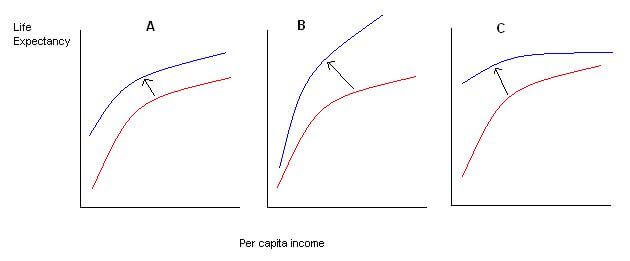
Credit: Wikipedia
- In India, the average annual per capita income rose from around ₹9,000 in 1947 to around ₹55,000 in 2011. During the same period, the average life expectancy increased from 32 to over 66 years.
|
{GS3 – S&T – Space} Akatsuki *
- Context (NDTV): Japan Aerospace Exploration Agency (JAXA) has confirmed that it lost contact with the spacecraft Akatsuki, humanity’s only mission to Venus. Akatsuki means “dawn” in Japanese.
- Japan’s first successful mission to explore another planet was launched in 2010.
- Akatsuki is in an equatorial elongated orbit with a westward revolution that matches the Venusian atmosphere, which rotates westward.
- It complements the European Space Agency’s (ESA) Venus Express, which orbited Venus until 2014.
Objectives of mission
- Akatsuki is the Venus Climate Orbiter mission (PLANET-C), which is designed to observe Venus’s toxic atmosphere and super-hot volcanic surface in three dimensions.
- To study weather patterns on Venus, lightning in thick clouds, and search for signs of active volcanism.
- It is also supposed to study the super-rotation in Venus’s atmosphere, which is caused by strong winds estimated to be faster than 360 kph.
- Meteorological information is to be obtained by globally mapping clouds and minor constituents successively with four cameras at ultraviolet and infrared wavelengths.
- These cameras detect lightning with a high-speed imager and observe the vertical structure of the atmosphere with radio science techniques.
{Prelims – Envi – Species} Forest eagle owl (Bubo Nipalensis)
- Context (TOI): Maharastra Pench Tiger Reserve reports the first photographic record of the forest eagle owl, also known as the spot-bellied eagle owl.

Credits: Wikipedia
This species is considered part of a superspecies with the barred eagle owl, which looks quite similar but is allopatric in distribution.

- A Superspecies is an informal rank for a species complex around one “representative” species. Species forming a superspecies must have allopatric distributions.
- Allopatric speciation is a mode of speciation that occurs when biological populations become geographically isolated from each other to an extent that prevents or interferes with gene flow.
|
- Appearance: Greyish-brown bird with dark, coarse brown colouration over the back and upper wings.
- Distribution: Himalayan foothills and the Western Ghats.
- Habitat: Dense evergreen and moist deciduous forests, usually near water, in wet temperate and riparian forests. Also hunts in scrub, bamboo jungle, thin deciduous forest, and near edges of clearings.
- Unique calls: Low-frequency calls for various purposes, including communication, territorial defence, and attracting mates. Low-frequency calls enable them to communicate further across long distances through dense vegetation. They also utter a mournful, mewing scream.
- Raven Pro software is used to calculate the frequency of animal calls.
|
- Conservation status: IUCN: LC | CITES: Appx. II. WPA 1972: Schedule I.
{Prelims – In News} Great Trigonometric Survey (GTS) Observatory
- Context (TH): The only surviving GTS observatory in Bengaluru was demolished by miscreants.
- It was a part of the Great Trigonometric Survey (GTS) by the East India Company in the 1800s.
About Great Trigonometric Survey (GTS)
- In 1800, Brigade-Major William Lambton proposed an ambitious ‘Mathematical and Geographical Survey’ to accurately map India and help determine the Earth’s exact shape.
- Later known as the Great Trigonometrical Survey (GTS), it began by measuring a baseline near Bengaluru.
{Prelims – In News} Green-Beard Genes
- Context (TH): Scientists have found that the green-beard genes are the reason behind natural altruism by studying the amoeba Dictyostelium discoideum.
- These genes allow the individuals bearing them to recognise and cooperate with each other. While, they could provoke individuals to behave harmfully towards those carrying a different version of the gene.
Altruism in Nature
- Altruism is the behaviour of an animal that is not beneficial to or may be harmful to itself but that benefits others of its species.
- Examples of altruism in nature are:
- Worker honey bees spend their entire lives foraging and caring for the queen and her offspring without reproducing themselves.
- Male widow spider allows the female he fertilised to eat him, nourishing herself and their offspring.
- A meerkat (a mongoose found in Africa) acts as a sentinel, watching for predators from a high perch while the rest of the clan feeds.
{Prelims – In News} ‘Phenome India’ Project
- Context (PIB): The Council of Scientific and Industrial Research (CSIR) announced the successful conclusion of the first phase of the health monitoring project, the ‘Phenome India-CSIR Health Cohort Knowledgebase’ (PI-CheCK).
- The PI-CheCK Project is the first pan-India longitudinal study conducted to develop an enhanced prediction model for cardiometabolic diseases, especially diabetes, liver diseases, and cardiac diseases.
- The participants who have volunteered to provide comprehensive health data include CSIR employees, pensioners, and their spouses from across 17 states and 24 cities.
- Benefits of the project:
- Understand the mechanisms behind the rising risk and incidence of cardiometabolic disorders: This will help develop new strategies for the prevention and management of these major diseases
- Overcome risk prediction algorithms limitations: Current prediction models, based on epidemiological data from Caucasian populations, may not be accurate for the Indian population due to ethnic diversity, genetic variations, and different lifestyle and dietary habits.
- Cardiometabolic diseases are caused by genetic and lifestyle factors. They are non-communicable.
|
Newsletter Updates
Subscribe to our newsletter and never miss an important update!
Assured Discounts on our New Products!













![PMF IAS Environment for UPSC 2022-23 [paperback] PMF IAS [Nov 30, 2021]…](http://pmfias.b-cdn.net/wp-content/uploads/2024/04/pmfiasenvironmentforupsc2022-23paperbackpmfiasnov302021.jpg)

